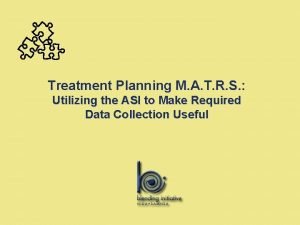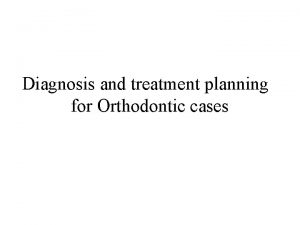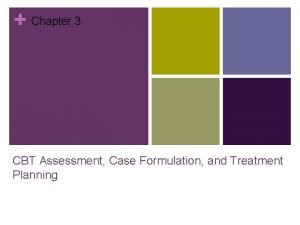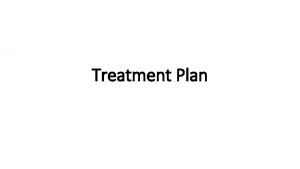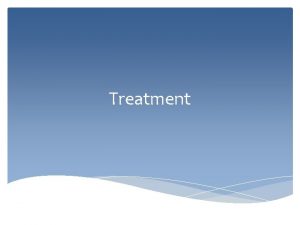Treatment Plan Treatment Plan Introduction A treatment plan









- Slides: 9

Treatment Plan

Treatment Plan Introduction • A treatment plan must be submitted quarterly to the University of Florida College of Pharmacy for research on the safety and efficacy of low-THC cannabis • The research to be performed by the University of Florida College of Pharmacy focuses on drug safety surveillance of low-THC cannabis, with a particular emphasis on the examination of treatment patterns, effectiveness, and safety • Drug safety surveillance is as good as the strength and integrity of the data provided in the treatment plan

Key Parts of Treatment Plan • Once the low-THC cannabis has been ordered, the physician must maintain a treatment plan that includes at least the following: § Patient identifier § Clinical history and condition § Dose and Type of administration (oil, injection, edibles, other) § Planned duration § Monitoring of the patients symptoms § Other indicators of tolerance or reaction to the low-THC cannabis § Initial vs Follow-up Treatment Plan 3

Treatment Plan • Paper-based forms available; may be completed on a fillable form • Complete the form marked “INITIAL” for the submission of the treatment plan when ordering cannabis for the first time for each patient • For all subsequent treatment plans, use the form marked “FOLLOW-UP” • Each form is two pages in length 4

Initial Treatment Plan • Indicate when the treatment plan was prepared • Identify the registry ID number for the patient for whom cannabis was ordered and provide the other requested information about the patient • Information about the ordering physician is requested. In instances when the patient is younger than 18 years old, include the name of the concurring physician. • Next, provide information about the contents of the cannabis order entered into the registry 5

Initial Treatment Plan Clinical History and Condition • Document the patient’s chief complaint that led to the evaluation of the patient for cannabis treatment • List symptoms observed or reported to you and describe each symptom in terms of its type, frequency, severity, and duration • Identify the prior treatment(s) employed, how long each was used and the outcomes • Describe the patient’s social history, comorbidities, and current medications 6

Initial Treatment Plan Monitoring Plan and Severity of Illness • Describe your plan for managing the patent by stating the treatment goals • Discuss your monitoring plan for the patient’s symptoms and when you plan to follow-up next with the patient • Based on your examination of the patient, describe how ill the patient is at this time by selecting one of the seven categories • Submit the treatment plan to the University of Florida College of Pharmacy per instructions at the bottom of form 7

Follow-Up Treatment Plan • Each quarter after submitting the initial treatment plan, a follow-up treatment plan must be prepared and submitted to the University of Florida • After completing the patient and physician information, indicate whether any change in the cannabis order was entered into the registry and why • Update the planned duration for treatment • Update the clinical history by indicating any changes in the chief complaint, symptoms, comorbidities, and current medications 8

Follow-Up Treatment Plan Reactions to Cannabis and Outcomes • Describe whether the patient is experiencing problems associated with the use of low-THC cannabis by describing any indicators of tolerance or reaction to the cannabis during the last quarter • Indicate any instances where the patient discontinued cannabis during the past quarter • Provide any changes to the treatment goals and the monitoring plan • Compared to the patient’s condition at initiation of cannabis treatment, indicate whether the patient’s condition has worsened or improved by selecting one of the seven categories • Submit the Follow-Up treatment plan to the University of Florida 9
